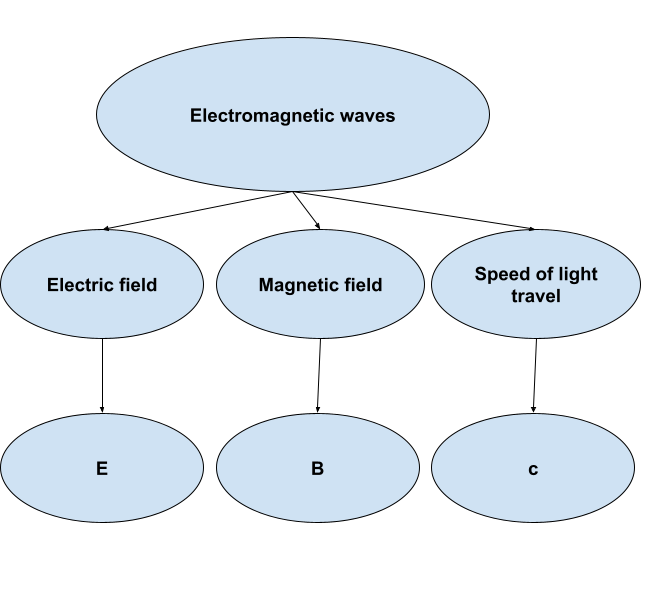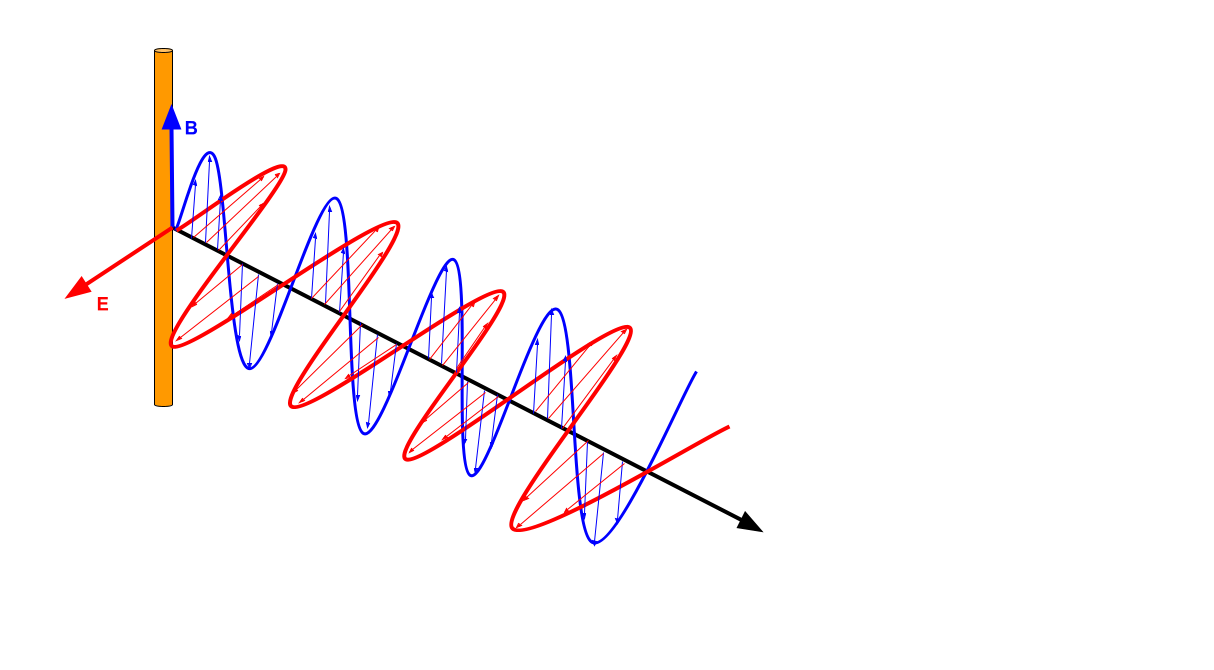All Solutions
Page 718: Assessment

Charge = q = $1.6 times 10^{-19} C$
q = $1.6 times 10^{-19} C$
90^circ
$$

$$
frac{E}{B}=frac{frac{textrm{N}}{textrm{C}}}{frac{textrm{N}}{textrm{A}cdot textrm{m}}}
$$
$$
frac{E}{B}=frac{textrm{A}cdottextrm{m}}{textrm{C}}=frac{textrm{C}cdottextrm{m}}{textrm{C}cdottextrm{s}}
$$
Which finally gives
$$
boxed{frac{E}{B}=frac{textrm{m}}{textrm{s}}}
$$
Q.E.D.
frac{E}{B}=frac{textrm{m}}{textrm{s}}
$$
a) Longest wavelengths belong to radio waves.
b) The highest frequencies belong to X-rays.
c) They all travel with the same speed, the speed of light.
b) X-rays
c) All have the same speed, $c$.
$$
E=vB
$$
From which we express the magnetic field as
$B=frac{E}{v}=frac{5.8times 10^3}{3.6times 10^4}$
Finally,
$$
boxed{B=0.16textrm{ T}}
$$
B=0.16textrm{ T}
$$
$$
qvB=frac{mv^2}{r}
$$
From here, we can express the radius to have that
$$
r=frac{mv}{qB}=frac{1.67times 10^{-27}times 5.4times 10^4}{1.6times 10^{-19}times 0.06}
$$
Finally, we have that
$$
boxed{r=9.4times 10^{-3}textrm{ m}}
$$
r=9.4times 10^{-3}textrm{ m}
$$
$$
qvB=frac{mv^2}{r}
$$
However, we have to find the speed first. We can do this by employing the conservation of energy which says
$$
frac{mv^2}{2}=qV
$$
So we get that
$$
v^2=frac{2qV}{m}
$$
Now, we obtain that
$$
qB=frac{m}{r}cdotsqrt{frac{2qV}{m}}
$$
which gives that the magnetic field is given as
$$
B=sqrt{frac{2mV}{qr^2}}=sqrt{frac{2times9.11times 10^{-31}times 4.5times 10^3}{1.6times 10^{-19}times 5^2times 10^{-4}}}
$$
Which finally gives that
$$
boxed{B=4.5times 10^{-3}textrm{ T}}
$$
B=4.5times 10^{-3}textrm{ T}
$$
$$
frac{q}{m}=frac{2V}{r^2B^2}
$$
From which mass can be expressed as
$$
m=frac{qr^2B^2}{2V}=frac{2times 1.6times 10^{-19}times 8^2times 10^{-4}times 0.077^2}{2times 156}
$$
Finally, one gets that
$$
boxed{m=3.9times 10^{-26}textrm{ kg}}
$$
m=3.9times 10^{-26}textrm{ kg}
$$
$$
qvB=frac{mv^2}{r}
$$
a) From here, one can express the speed as
$$
v=frac{qrB}{m}=frac{2times 2times 1.6times 10^{-19}times 0.15}{6.6times 10^{-27}}
$$
Finally, we have that
$$
boxed{v=1.45times 10^7frac{textrm{ m}}{textrm{ s}}}
$$
b) The kinetic energy is to be found via its standard expression
$$
K=frac{mv^2}{2}=frac{6.6times 10^{-27}times 1.45^2times 10^{14}}{2}
$$
Which gives that
$$
boxed{K=6.9times 10^{-13}textrm{ J}}
$$
c) Now, the potential difference that corresponds to that energy is found from
$$
K=qV
$$
$$
V=frac{6.9times 10^{-13}}{2times1.6times 10^{-19}}
$$
Eventually, we get
$$
boxed{V=2.2 times 10^6textrm{ V}}
$$
textrm{a) }v=1.45times 10^7frac{textrm{ m}}{textrm{ s}}
$$
$$
textrm{b) }K=6.9times 10^{-13}textrm{ J}
$$
$$
textrm{c) }V=2.2 times 10^6textrm{ V}
$$
$$
S=(1-frac{175times10^3}{175times10^3+1})times 100
$$
Which gives that
$$
boxed{S=0.0006%}
$$
S=0.0006%
$$
$$
frac{q}{m}=frac{2V}{r^2B^2}
$$
Here we see that $mpropto r^2$ so we can write
$$
frac{m_1}{m_2}=frac{r_1^2}{r_2^2}
$$
which gives us that the mass of the second isotope is
$$
m_2=m_1times frac{r_2^2}{r_1^2}=28m_ptimes frac{0.1797^2}{0.1623^2}
$$
Which finally gives that
$$
boxed{m_2=34m_p}
$$
m_2=34m_p
$$
$$
lambda=frac{c}{f}=frac{3times 10^8}{66times 10^6}
$$
Which gives that
$$
lambda=4.5textrm{ m}
$$
Now, the distance between the bars of the antenna is
$$
d=frac{lambda}{4}=frac{4.5}{4}
$$
Finally,
$$
boxed{d=1.1textrm{ m}}
$$
d=1.1textrm{ m}
$$
$$
f=frac{c}{lambda}=frac{3times 10^8}{650times 10^{-9}}
$$
Which gives that
$$
boxed{f=4.6times 10^{14}textrm{ Hz}}
$$
f=4.6times 10^{14}textrm{ Hz}
$$
$$
lambda=frac{c}{f}=frac{3times 10^8}{101.3times 10^6}
$$
Which gives that
$$
lambda=2.96textrm{ m}
$$
Now, the optimum length of the antenna is $d=frac{lambda}{2}$
$$
d=frac{lambda}{2}=frac{2.96}{2}
$$
Finally,
$$
boxed{textrm{d=1.48textrm{ m}}}
$$
textrm{d=1.48textrm{ m}}
$$
$$
lambda=frac{c}{f}=frac{3times 10^8}{8times 10^8}
$$
Which gives that
$$
lambda=0.375textrm{ m}
$$
Now, the optimum length of single-end antennas is $d=frac{lambda}{4}$ as given in the problem
$$
d=frac{lambda}{4}=frac{0.375}{4}
$$
Finally,
$$
boxed{d=0.0938textrm{ m}}
$$
d=0.0938textrm{ m}
$$
$$
N=frac{2.7times 10^{-26}}{1.67times 10^{-27}}
$$
$$
boxed{N=16textrm{ amu}}
$$
N=16textrm{ amu}
$$
$$
lambda=frac{c}{f}=frac{3times 10^8}{94.5times 10^6}
$$
Which gives that
$$
lambda=3.17textrm{ m}
$$
Now, the optimum length of an antenna is $d=frac{lambda}{2}$
$$
d=frac{lambda}{2}=frac{3.17}{2}
$$
Finally,
$$
boxed{d=1.59textrm{ m}}
$$
d=1.59textrm{ m}
$$
$$
d=frac{lambda}{4}
$$
So we can express the wavelength as
$$
lambda=4d
$$
On the other hand, the frequency is given as
$$
f=frac{c}{lambda}=frac{c}{4d}=frac{3times 10^8}{4times 0.083}
$$
Finally, we have that
$$
boxed{f=9.04times 10^8textrm{ Hz}}
$$
f=9.04times 10^8textrm{ Hz}
$$
$$
frac{q}{m}=frac{2V}{r^2B^2}=frac{2times 150}{0.098^2times50^2 times 10^{-6}}
$$
Finally, the charge-to-mass ratio is
$$
boxed{frac{q}{m}=12.5times 10^{6}frac{textrm{ C}}{textrm{ kg}}}
$$
frac{q}{m}=12.5times 10^{6}frac{textrm{ C}}{textrm{ kg}}
$$
$$
v_{target}=frac{cf_{Doppler}}{2f_{transmitted}}=frac{3times 10^8times 1850}{2times 10.525times 10^9}
$$
Which finally gives that
$$
boxed{v=26.4frac{textrm{m}}{textrm{s}}}
$$
v=26.4frac{textrm{m}}{textrm{s}}
$$
$$
frac{q}{m}=frac{2V}{r^2B^2}
$$
So we can express the radius as
$$
r=sqrt{frac{2mV}{qB^2}}
$$
Since we know that our detector has the spacing $d=0.1times 10^{-3}$ m we have that
$$
d=2times(r_{176}-r_{175})=2times(sqrt{frac{2m_{176}V}{qB^2}}-sqrt{frac{2m_{175}V}{qB^2}})
$$
Which after we transfer the masses into proton masses gives
$$
d=2timessqrt{frac{2m_pV}{qB^2}}(sqrt{176}-sqrt{175})
$$
Therefore, if we take that $V_{min}=500$ V we can express $B$ as
$$
B=2timesfrac{sqrt{2Vm_p}(sqrt{176}-sqrt{175})}{dsqrt{q}}=2timesfrac{sqrt{2times 500times1.67times 10^{-27}}(sqrt{176}-sqrt{175})}{0.1times 10^{-3}times sqrt{1.6times 10^{-19}}}
$$
Finally, the magnetic field should be
$$
boxed{B=2.4textrm{ T}}
$$
B=2.4textrm{ T}
$$
The number of remote controls flourished in the last decades with the average US household having as many as four remotes. The reason for this is exactly the one given in the problem, since the IR spectrum is broad enough many devices can be uniquely coded and it is not likely to have interference. However, with their number still increasing, the mentioned interference becomes a plausible option. Therefore, some tweaks have been made to reduce the number of IR controls. One of them is the existence of universal IR remotes. Second is, IR remote via smartphones, a very popular option nowadays.
$$
a=frac{L}{y_1}lambda
$$
Where $L$ is the distance to the screen. After we plug in the values
$$
a=frac{0.95}{8.5times 10^{-3}}times 633times 10^{-9}
$$
Finally, the width of the slit is
$$
boxed{a=71times 10^{-6}textrm{ m}}
$$
a=71times 10^{-6}textrm{ m}
$$
$F = dfrac{K (4q) (2q)}{r^2}$
$F = dfrac{8 K q^2}{r^2}$
The total charge on the spheres is:
$q_{net} = q_1 + q_2 = (-4q) + (2q) = -2q$
After connecting the spheres, charges on each of the spheres is the half of the $q_{net}$:
$q’_1 = q’_2 = -q$
The force between them:
$F’ = dfrac{K q_1 q_2}{r^2}$
$= dfrac{K q^2}{r^2}$
$$
= dfrac{1}{8} F
$$
dfrac{1}{8} F
$$
$$
E=frac{Delta V}{Delta x}=frac{45}{0.012}
$$
Finally, we get that
$$
boxed{E=3.8times 10^3 frac{textrm{V}}{textrm{m}}}
$$
E=3.8times 10^3 frac{textrm{V}}{textrm{m}}
$$
$$
P=IV
$$
$$
P=120times 245=2.94 textrm{ kW}
$$
Since the compressor is operating one quarter of the time the daily cost is now given as
$$
textrm{cost}=Pttimes 0.095=2.94times 6 times 0.095
$$
Finally, we have that
$$
boxed{textrm{cost}=1.68$}
$$
textrm{cost}=1.68$
$$
$$
F=IBL
$$
From here we can express the magnetic field as
$$
B=frac{F}{IL}=frac{0.55}{7.7times4.4}
$$
So finally we have that
$$
boxed{=16times 10^{-3}textrm{ T}}
$$
B=16times 10^{-3}textrm{ T}
$$

